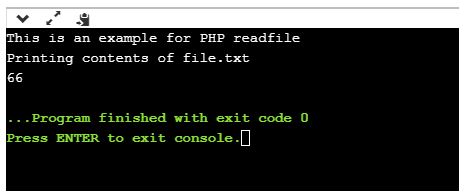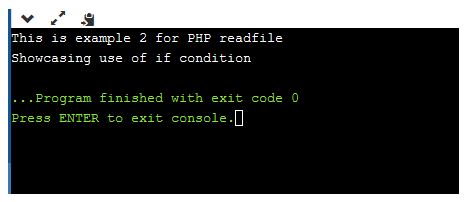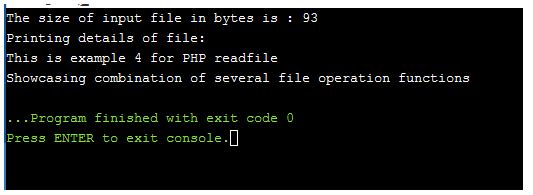PHP readfile
PHP readfile is basically an inbuilt function in the PHP library used for reading a file and then writing it to an output buffer.
Start Your Free Software Development Course
Web development, programming languages, Software testing & others
Syntax:
readfile ( string $file_name [, boolean $path = FALSE [, resource $context ]] ) : int
The parameters being used in the syntax:
- filename: It is a mandatory field where we provide the name of the file to be read.
- path: This is an optional parameter and is a boolean value that can be set to either true or false if the file needs to be searched in the provided path.
- context: This is also an optional field which is used to specify the context of the file handle. Basically a context is a collection of objects having an ability to change the behavior of that stream. It returns the number of bytes which is read from the file if success and returns false if failed to read.
Methods of PHP readfile
Apart from readfile() function, below are some of the other functions that can be used for performing various kinds of operations on the files.
1. file()
This function is also used to read a file and it reads the complete file into an array.
Syntax:
file ( string $file_name [, int $flag = 0 [, resource $context ]] ) : array
where file_name is the path to the file to be read. Flags are the optional fields which can be chosen from the below constants:
- FILE_USE_INCLUDE_PATH: To search for the respective file in the given path.
- FILE_IGNORE_NEW_LINES: To omit a new line at the last of each array element.
- FILE_SKIP_EMPTY_LINES: To skip empty lines.
It returns the file present in the array upon success and false upon failure.
2. fopen()
This function can be used to open both a file and a URL.
fopen ( string $file_name , string $mode [, bool $use_include_path = FALSE [, resource $context ]] ) : resource
- where if file_name is a URL then PHP searches a protocol handler (also called as a wrapper) for it. The PHP will issue a notice to help track possible problems in the script and then continue considering it as a normal regular file_name.
- Suppose if the file_name is a local file then PHP tries to open the same stream on that file. The file will be accessible by PHP only if required permissions are granted for its access.
- And suppose the given file_name is a registered protocol and if that one is registered as a network URL then the first PHP ensures that the allow_url_fopen is enabled. It will issue a warning and fail if it is disabled.
Mode: This parameter mentions the kind of access required to be given to the stream.’ Below are few important modes:
- r – read mode only
- r+ – both read and write only
- w – write mode only
It returns a file pointer resource if success and false on failure.
3. fread()
This function is used for binary-safe file read.
Syntax:
fread ( resource $handle , int $length ) : string
where the handle is used for referencing the file pointer.
The file is read until it reaches one of the below conditions: length in bytes must have been read, EOF is reached, socket timeout occurs. fgets(), fscanf(), ftell(), fwrite(), fopen(), fsockopen() are a few other functions used for file operations in PHP.
Examples of PHP readfile
Given below are the examples of PHP readfile:
Example #1
Code:
<?php
// it is writing content of file to output
// buffer used in readfile() function
echo readfile("file.txt");
?>Output:

This shows a basic example to read a file existing in the local path. Make sure that the filename being specified in the parameter of readfile() function is created and the content to be read is present inside the file. When the readfile() function is used it reads the content of the file and prints in the output.
Example #2
Code:
<?php
/ file contents written on output
// buffer by readfile() function
$file = @readfile("file.txt");
if (!$file)
{
print "File could not be opened";
}
?>Output:

The previous output was a simple example without any conditions. In this example, let us see how to read and display the output of a file by using certain conditions. We are using if statement to print suppose the file is not present.
Example #3
Code:
<?php $file_name = "file.txt"; $fh = fopen($file_name, 'r'); $data = fread($fh, filesize($file_name)); fclose($fh); echo $data; ?>
Output:

In this example, we are combining the use of multiple file read functions. As in all the above examples, first, we are giving the file name which needs to be read from. Then the mode of operation, ‘r’ is given to them indicating it can only be read. filesize() function takes the filename and returns the size of the file along with its data and assigns it to $data variable. By using fclose() function we are closing that file. Finally, the data is printed as output.
Example #4
Code:
<?php
$file_name = "file.txt";
$file = fopen( $file_name , "r" );
if( $file == false ) {
echo ( "Error in opening file" );
exit();
}
$size = filesize( $file_name );
$filetext = fread( $file, $size);
fclose( $file );
echo ( "The size of input file in bytes is : $size\n" );
echo ("Printing details of file:\n");
echo ( $filetext );
?>Output:

Before running the code, make sure that the file to be read file.txt is created in the local file path. In this example first, we are declaring the file name to be read and opening that with the function fopen(). Suppose the file does not exist, using if condition we are throwing an error message. Finally, we are printing the file size and the content present in the input file.
Conclusion
As seen from all the above examples, readfile() is one of the main functions of PHP used for reading the file name specified in this function. Apart from readfile() we have covered a few other file operations which perform similar actions such as fopen, file, fread, fgets, fgetss, ftell, etc. A combination of all of these are basically used in accessing and performing operations on the input file.
The above is the detailed content of PHP readfile. For more information, please follow other related articles on the PHP Chinese website!

Hot AI Tools

Undresser.AI Undress
AI-powered app for creating realistic nude photos

AI Clothes Remover
Online AI tool for removing clothes from photos.

Undress AI Tool
Undress images for free

Clothoff.io
AI clothes remover

AI Hentai Generator
Generate AI Hentai for free.

Hot Article

Hot Tools

Notepad++7.3.1
Easy-to-use and free code editor

SublimeText3 Chinese version
Chinese version, very easy to use

Zend Studio 13.0.1
Powerful PHP integrated development environment

Dreamweaver CS6
Visual web development tools

SublimeText3 Mac version
God-level code editing software (SublimeText3)

Hot Topics
 1380
1380
 52
52
 PHP 8.4 Installation and Upgrade guide for Ubuntu and Debian
Dec 24, 2024 pm 04:42 PM
PHP 8.4 Installation and Upgrade guide for Ubuntu and Debian
Dec 24, 2024 pm 04:42 PM
PHP 8.4 brings several new features, security improvements, and performance improvements with healthy amounts of feature deprecations and removals. This guide explains how to install PHP 8.4 or upgrade to PHP 8.4 on Ubuntu, Debian, or their derivati
 How To Set Up Visual Studio Code (VS Code) for PHP Development
Dec 20, 2024 am 11:31 AM
How To Set Up Visual Studio Code (VS Code) for PHP Development
Dec 20, 2024 am 11:31 AM
Visual Studio Code, also known as VS Code, is a free source code editor — or integrated development environment (IDE) — available for all major operating systems. With a large collection of extensions for many programming languages, VS Code can be c
 7 PHP Functions I Regret I Didn't Know Before
Nov 13, 2024 am 09:42 AM
7 PHP Functions I Regret I Didn't Know Before
Nov 13, 2024 am 09:42 AM
If you are an experienced PHP developer, you might have the feeling that you’ve been there and done that already.You have developed a significant number of applications, debugged millions of lines of code, and tweaked a bunch of scripts to achieve op
 How do you parse and process HTML/XML in PHP?
Feb 07, 2025 am 11:57 AM
How do you parse and process HTML/XML in PHP?
Feb 07, 2025 am 11:57 AM
This tutorial demonstrates how to efficiently process XML documents using PHP. XML (eXtensible Markup Language) is a versatile text-based markup language designed for both human readability and machine parsing. It's commonly used for data storage an
 Explain JSON Web Tokens (JWT) and their use case in PHP APIs.
Apr 05, 2025 am 12:04 AM
Explain JSON Web Tokens (JWT) and their use case in PHP APIs.
Apr 05, 2025 am 12:04 AM
JWT is an open standard based on JSON, used to securely transmit information between parties, mainly for identity authentication and information exchange. 1. JWT consists of three parts: Header, Payload and Signature. 2. The working principle of JWT includes three steps: generating JWT, verifying JWT and parsing Payload. 3. When using JWT for authentication in PHP, JWT can be generated and verified, and user role and permission information can be included in advanced usage. 4. Common errors include signature verification failure, token expiration, and payload oversized. Debugging skills include using debugging tools and logging. 5. Performance optimization and best practices include using appropriate signature algorithms, setting validity periods reasonably,
 PHP Program to Count Vowels in a String
Feb 07, 2025 pm 12:12 PM
PHP Program to Count Vowels in a String
Feb 07, 2025 pm 12:12 PM
A string is a sequence of characters, including letters, numbers, and symbols. This tutorial will learn how to calculate the number of vowels in a given string in PHP using different methods. The vowels in English are a, e, i, o, u, and they can be uppercase or lowercase. What is a vowel? Vowels are alphabetic characters that represent a specific pronunciation. There are five vowels in English, including uppercase and lowercase: a, e, i, o, u Example 1 Input: String = "Tutorialspoint" Output: 6 explain The vowels in the string "Tutorialspoint" are u, o, i, a, o, i. There are 6 yuan in total
 Explain late static binding in PHP (static::).
Apr 03, 2025 am 12:04 AM
Explain late static binding in PHP (static::).
Apr 03, 2025 am 12:04 AM
Static binding (static::) implements late static binding (LSB) in PHP, allowing calling classes to be referenced in static contexts rather than defining classes. 1) The parsing process is performed at runtime, 2) Look up the call class in the inheritance relationship, 3) It may bring performance overhead.
 What are PHP magic methods (__construct, __destruct, __call, __get, __set, etc.) and provide use cases?
Apr 03, 2025 am 12:03 AM
What are PHP magic methods (__construct, __destruct, __call, __get, __set, etc.) and provide use cases?
Apr 03, 2025 am 12:03 AM
What are the magic methods of PHP? PHP's magic methods include: 1.\_\_construct, used to initialize objects; 2.\_\_destruct, used to clean up resources; 3.\_\_call, handle non-existent method calls; 4.\_\_get, implement dynamic attribute access; 5.\_\_set, implement dynamic attribute settings. These methods are automatically called in certain situations, improving code flexibility and efficiency.




